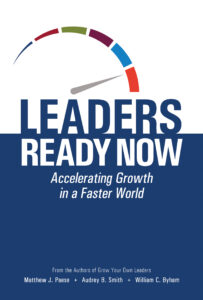When You Need Leaders Fast
Most of us leading organizations are thinking about it all the time. Great strategy means nothing if you don’t have the people to make it happen.
If you want to lead, if you want to accelerate your growth, if you want to energize your company, you need to have a talent management system that produces leaders.
In Leaders Ready Now: Accelerating Growth in a Faster World, authors Matthew Paese, Ph.D., Audrey B. Smith, Ph.D., and William C. Byham, Ph.D. share their collective wisdom about talent and leadership. All three authors are employed by DDI helping organizations grow their own leaders.
I recently spoke with Matt about the new book and the extensive research on talent and growing leaders in organizations.
Managing Talent in Your Organization
What’s working and not working with today’s talent management systems?
What’s working is that we know how to build processes, tools, and technology to help leaders learn. What’s not working is that all this “stuff” fails to generate the energy that fuels real growth. In fact, more often than not, the initiatives that are put in place to accelerate the growth of talent drain energy instead of creating it.
The learning experiences that leaders describe as the most beneficial are not necessarily the ones that we design for them. They tend to be the ones that happen on the fly. So we have to find ways to make the tools, technology and learning experiences that we design more useful and powerful on a day-to-day basis.
Make Leadership Development A Top Priority
With the increasing pressure to deliver immediate financial results, some leaders may discount leadership development. How do you make it a top business priority and keep it there where it belongs even in tough times?
There is a simple answer to this one: keep score or don’t play. But you can’t just keep score of anything. When we say ‘keep score,’ we mean something very specific. Frankly, this is where many companies get it wrong. It’s important to remember that most organizations invest in development so that they can create more capability, and they need it now, but they don’t keep score that way. It’s routine to see organizations declare growth-focused objectives while they only keep score of learning activity, engagement, or retention. It’s like scoring a basketball game by keeping track of how many players are on the court. It’s just not the right metric. Eventually people lose interest and frustration sets in, so programs become difficult to sustain.
A classic example of keeping score of the wrong thing is tracking how many people have development plans or how many people were satisfied with a learning initiative. Those may be interesting metrics, but they don’t say much about what happened to leadership capability as a result of the effort.
A measure of growth tracks the application of what has been learned or may keep track of changes in leadership readiness. For example, some organizations have begun scoring ‘conversions,’ which involve converting a leader from ‘not ready’ to ‘ready now.’ If you set targets against conversions (instead of learning activity or engagement) and establish clear accountability for who is responsible for generating them, the dynamics of a leadership acceleration system change dramatically, and management becomes much more competitive (in a good way) about growing talent.
Accelerating Talent Growth
1: Commit: adopt acceleration as a business priority.
2: Aim: define leadership success for your business context.
3: Identify: make efficient, accurate decisions about whom to accelerate.
4: Assess: accurately evaluate readiness gaps and give great feedback.
5: Grow: make the right development happen.
6: Sustain: aggressively manufacture the energy for growth.
Talk about leadership context and why it matters to leadership development.
In today’s environment, business context means constant change. This means that development needs to move at the speed of change. Learning content, and the tools, support, and technology that leaders need to apply it, must be directly applicable to their most pressing challenges. They simply don’t have time or mindshare to engage in the sort of extracurricular development that traditionally characterized leadership development.
If formal learning is to make a positive business difference, it must be supported by readily available and easy-to-use tools, job aids, technology, networks, and management support. Organizing these assets isn’t rocket science, but when it’s done right, the results show it. Decades of experience and research have generated big data that now shows convincingly that a handful of the right principles and practices make a profound difference in the outcomes of leadership development that is built to be context-specific.
Rethink Feedback
I especially love your chapter of rethinking feedback. What tips can you share for busy managers who want to provide feedback that inspires rapid growth?
Let’s face it. Feedback is difficult. When managers provide feedback, they tend to focus on the past, and what an individual may have done poorly or not well enough. This approach to feedback is challenging because it requires an individual to dwell on their shortcomings. The opposite is also common, when feedback is rare or so anemic that it has no impact. In the end, feedback messages are typically either too soft or too abrasive – rarely spot on.
In the context of accelerating growth, retrospective orientations don’t work as well as future-focused orientations. Managers seeking to give great feedback will inspire more positive action if they focus their feedback on the bright possibility that lies in the future, if and only if the individual can enhance his or her skills and gain more useful experiences. Then, they need to be able to get specific by using precise behavioral language to illustrate exactly what great leadership looks like in one or more of these future scenarios. In a word, great feedback causes an individual to aggressively pursue a bright future rather than regret an unfortunate past.
When to Use A Coach to Get Results
What makes a good coach?
A great coach establishes a relationship with a leader that allows for the opportunity to create tension. In addition to mastering the art of feedback (above), a great coach zeros in on a specific growth objective with an individual and then provides structure, guidance, confidence and clarity and how to reach it. Contrary to what is often written, this is not as much an art as it is a discipline. For individual leaders, the experience is like having a great fitness trainer—it doesn’t always feel good in the moment, but it gets results.
Why is it that some people respond to coaching while others continue to struggle? What helps coaching “stick”?
 The idea of having a coach often looks better on paper than it feels in practice. Many leaders sign up to have a coach, only to learn how difficult it may be when getting into the midst of a coaching relationship. Good coaches not only set clear objectives, they build healthy tension that pushes leaders into new and often different performance territory. Skilled coaches help leaders understand and gain confidence in their ability to achieve new heights. This is not a one-time agreement—this is a continual psychological contract that must be renewed again and again as an individual leader works through the challenges of evolving his or her own capabilities.
The idea of having a coach often looks better on paper than it feels in practice. Many leaders sign up to have a coach, only to learn how difficult it may be when getting into the midst of a coaching relationship. Good coaches not only set clear objectives, they build healthy tension that pushes leaders into new and often different performance territory. Skilled coaches help leaders understand and gain confidence in their ability to achieve new heights. This is not a one-time agreement—this is a continual psychological contract that must be renewed again and again as an individual leader works through the challenges of evolving his or her own capabilities.
You’ve observed hundreds of leaders and companies. When you walk into a room with a team of leaders who really “get it,” how would you describe them? In other words, what are the elements of a “leaders ready now” management team?
Two words: courage and candor. When talent-focused management teams interact, their focus is much more on the achievement of real growth than with feeling good or protecting egos. It’s always true that we want people to feel supported by the organization, and we must always work to retain and engage our best people. But to give talented people the respect they deserve, and also give the business the leadership it needs, it is essential to collaborate to generate growth opportunities that have true impact. This means confronting the human issues and challenges that people face as they take on new and ever-more-daunting problems. The management teams that do it best are fearless and focused without being callous. They take measured, data-driven approaches to understanding their people, and they carefully align them with business challenges that stretch their capabilities without taking irresponsible risks.
Leaders Ready Now: Accelerating Growth in a Faster World

